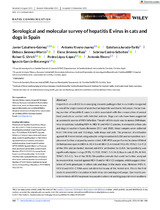Serological and molecular survey of hepatitis E virus in cats and dogs in Spain
Autor
Caballero-Gómez, Javier
Rivero-Juárez, Antonio
Jurado-Tarifa, Estefanía
Jiménez-Martín, Débora
Jiménez-Ruiz, Elena
Castro-Scholten, Sabrina
Ulrich, Rainer G.
Editor
WileyFecha
2021Materia
CatsDogs
Hepatitis E
Orthohepevirus A
Orthohepevirus C
Survey
Zoonoses
METS:
Mostrar el registro METSPREMIS:
Mostrar el registro PREMISMetadatos
Mostrar el registro completo del ítemResumen
Hepatitis E virus (HEV) is an emerging zoonotic pathogen that is currently recognized as one of themajor causes of acute human hepatitis worldwide. In Europe, the increasing number of hepatitis E cases is mainly associated with the consumption of animal food products or contact with infected animals. Dogs and cats have been suggested as a zoonotic source of HEV infection. The aim of this study was to assess Orthohepevirus circulation, including HEV-A, HEV-B and HEV-C species, in sympatric urban cats and dogs in southern Spain. Between 2017 and 2020, blood samples were collected from 144 stray cats and 152 dogs, both strays and pets. The presence of antibodies againstHEV were tested using a double-antigen sandwich ELISA and seropositive simples were further analysed bywestern blot.ART-PCR was performed to detect RNAof Orthohepevirus species (HEV-A,HEV-B andHEV-C).Atotal of 19 (6.4%; 95%CI: 3.6-9.2) of the 296 animals tested showed anti-HEV antibodies by ELISA. Seropositivity was significantly higher in dogs (9.9%; 15/152; 95%CI: 5.1-14.6) than in cats (2.8%; 4/144; 95%CI: 0.1-5.5). Ten of the 18 ELISA-positive animals that could be further analysed by western blot, reacted against HEV-3 and/or HEV-C1 antigens, which suggest circulation of both genotypes in urban cats and dogs in the study area. However, HEV-A, HEV-B and HEV-C RNA were not detected in any of the tested sera. This is the first study to assess HEV circulation in both stray cats and dogs in Europe. Our results provide evidence of HEV exposure in sympatric urban cat and dog populations in southern Spain. Further studies are needed to determine the role of these species in the epidemiology of HEV.

